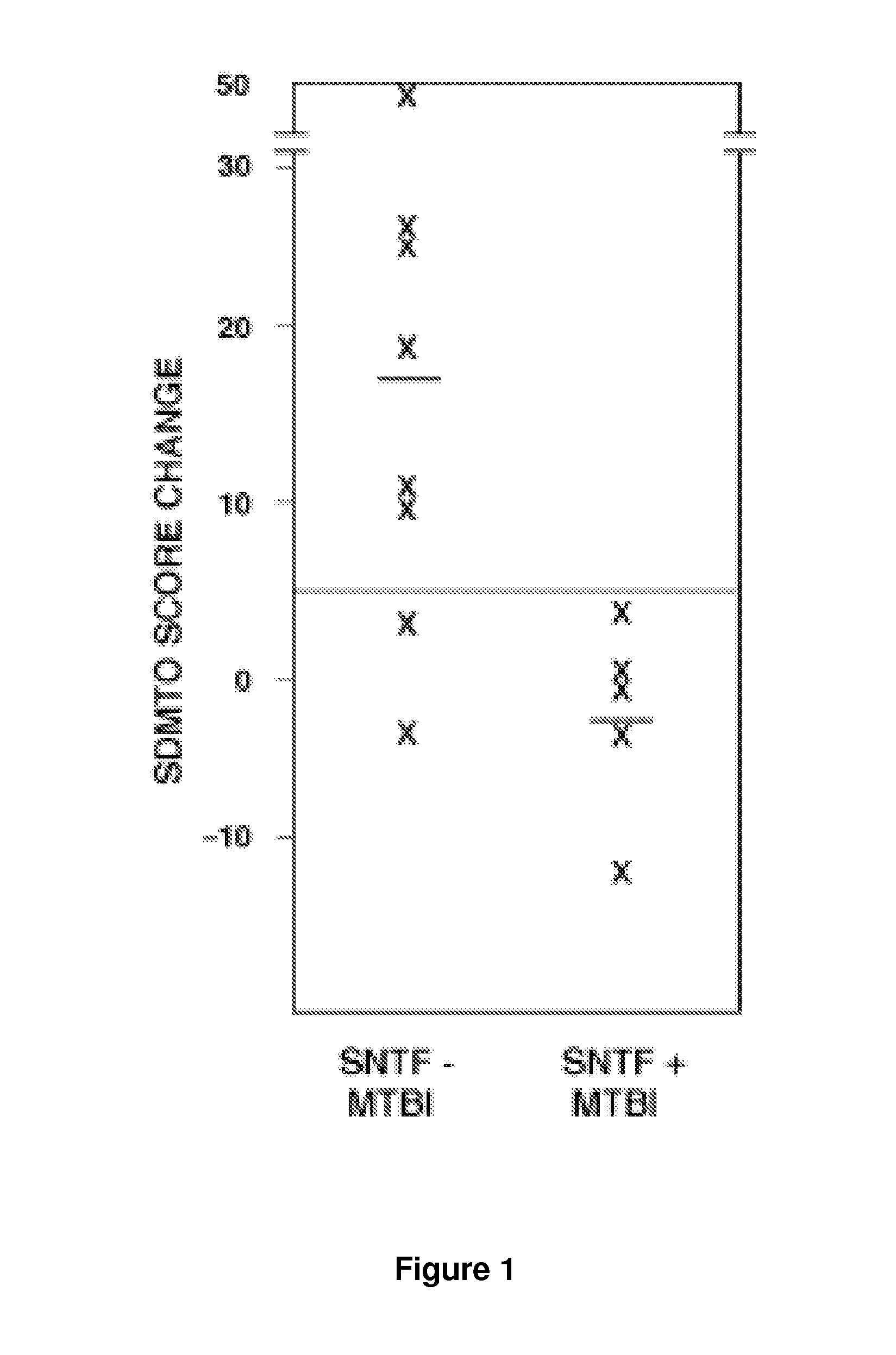A blood biomarker that predicts persistent cognitive dysfunction after concussion
a blood biomarker and cognitive dysfunction technology, applied in biochemistry apparatus and processes, instruments, library screening, etc., can solve the problems of long-term dysfunction, no means have emerged so far, inconsistent results
- Summary
- Abstract
- Description
- Claims
- Application Information
AI Technical Summary
Problems solved by technology
Method used
Image
Examples
example 1
Changes in Long-Term Cognitive Function in a Subset of mTBI Cases
[0129]A total of 38 participants provided plasma samples on the day of injury for quantification of the neurodegeneration biomarker SNTF: 17 were diagnosed with mTBI and 13 with orthopedic injury (OI), whereas 8 were uninjured controls (UC). The biomarker study subgroup did not differ from the overall study group in terms of initial injury severity, age, gender, or other factors (Table 1).
[0130]Among these cases, brain structural integrity was assessed by DTI within 4 days of injury for 28 of the participants, and brain performance was evaluated by neuropsychological testing within 4 days of injury and at 1 and 3 months thereafter for 27-29 of the participants, depending on the test battery. The three cohorts did not differ significantly from one another in age, gender, or level of education.
[0131]In comparison with OI and UC groups, the mTBI group demonstrated overall performance deficits at 3 months post-injury on th...
example 2
Plasma SNTF is Elevated in a Subset of mTBI Cases
[0132]We evaluated SNTF as a candidate plasma biomarker for human mTBI. This α-spectrin fragment is generated by the calpain family of cysteine proteases and accumulates in axons damaged by stretch injury in vitro or TBI in vivo. It is released from neurons upon plasma membrane disruption. SNTF has not been evaluated before as a prognostic marker in mTBI. Here, plasma SNTF measured on the day of injury was above the lower limit of detection of 10 units in an ultrasensitive sandwich immunoassay in a subset of participants: 7 of 17 mTBI cases and 3 of 13 OI cases. In contrast, plasma SNTF was below the lower limit of detection in all 8 UC participants. The immunoassay signals from the positive plasma samples were confirmed as being specific for SNTF, and not from heterophilic substances that can confound human plasma biomarker studies, by control experiments in which the SNTF-specific detecting IgG was replaced with pre-immune IgG isola...
example 3
Elevated Plasma SNTF on the Day of Injury is Related to White Matter Damage and Long-Term Cognitive Dysfunction
[0133]To examine the relationship between plasma SNTF levels on the day of mTBI and DAI, the 28 participants among the mTBI, 01, and UC cohorts with usable neuroradiological data were dichotomized as either SNTF positive or negative, and the two groups were evaluated comparatively for axon tract structural abnormalities by DTI. Compared with the 19 SNTF negative cases analyzed by DTI within 4 days of injury, the 9 SNTF positive cases exhibited significant reductions in FA and increases in ADC in the corpus callosum and uncinate fasciculus (p<05; Table 2). The FA and ADC are thought to quantify the orientation and structural integrity of white matter, and their differences as a function of dichotomized plasma SNTF levels provide evidence that plasma elevations in this neurodegeneration biomarker after injury may be related to DAI.
TABLE 1Representativeness of biomarker study ...
PUM
| Property | Measurement | Unit |
|---|---|---|
| molecular mass | aaaaa | aaaaa |
| temperatures | aaaaa | aaaaa |
| pH | aaaaa | aaaaa |
Abstract
Description
Claims
Application Information
 Login to View More
Login to View More - R&D
- Intellectual Property
- Life Sciences
- Materials
- Tech Scout
- Unparalleled Data Quality
- Higher Quality Content
- 60% Fewer Hallucinations
Browse by: Latest US Patents, China's latest patents, Technical Efficacy Thesaurus, Application Domain, Technology Topic, Popular Technical Reports.
© 2025 PatSnap. All rights reserved.Legal|Privacy policy|Modern Slavery Act Transparency Statement|Sitemap|About US| Contact US: help@patsnap.com

